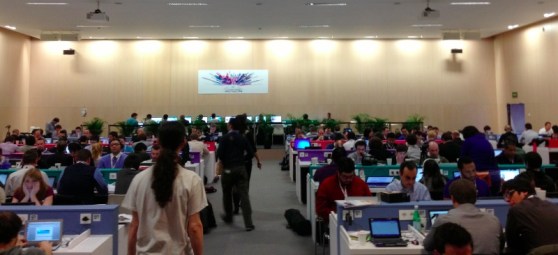
I always get asked, “What was the big theme at MWC this year?”
It’s a hard question to answer, since there is so much going on. But there is one way to gauge it, by looking at who is exhibiting, how big the space is that they rented, and where the are booths in relation to each other.
This is not a perfect analysis, because some companies choose not to attend (Apple being the prime example). But there is a message even in absence. Two years ago, Nokia decided not to have a booth, but Samsung took its spot and then a year later overtook its market share.
At this point, you probably know more about the specific news coming out of Barcelona than I do. From the ground, there’s no way to keep track of all the press releases and keynotes. Every once and while someone mentions some tidbit. And I start every meeting by asking each company what they are announcing at the show. But that’s just a small sliver of the data flow.
Its hard to keep up because this show is crowded. Its a giant space, but at times the walkways are complete gridlock. First conclusion: This is a healthy industry.
The big handset vendor booths are crowded. Samsung’s sprawling expense feels like a high end department store, there’s so much on offer. Huawei, LG, Sony and ZTE all have some nice phones on display, and their smaller ‘booths’ are buzzing. The HTC booth features gymnasts, and what is often mentioned as the best phone introduced at the show. The Nokia booth features a massive conga line every hour. They have some phones too. The only exception to the merriment is the Motorola booth. For some reason they decided to decorate their showspace with high walls and climbing vines, so it’s hard not to think of Ancient Roman ruins. They have two models on display, the Droid RAZR HD and RAZRi, both of which are at six months old at least. And neither was running the latest version of Android, even though Motorola is now part of Google’s corporate family. The assumption is that Motorola is saving its best for Google I/O in May, which is odd because carriers buy phones in bulk at MWC, not at I/O.
Different halls focus on different types of companies. This year Hall 3 seems to have the largest booths. Qualcomm, Intel, Samsung, Nokia, and Alcatel all seem to have a half acre apiece there. The smaller networking and backhaul equipment vendors congregate in Hall 7. Hall 8 is where you find the app and monetization companies. This is not a perfect system, but it helps to keep track of what’s what.
It is hard to do a precise analysis because this venue is bigger than that of past shows, but you could probably learn something meaningful by comparing the amount of floor space reserved for each kind of company.
For instance, “App Planet” used to be lots of small stands from dozens of app and game vendors. Now it is home to large exhibitions from ad networks, analytics companies, and gaming studios like Gree.
Big telco vendors like Alcatel, Ericsson, Huawei, and Nokia Siemens all have huge spaces, but the antenna, base station component, power system and cabling companies now consume far less square footage than in the past.
One thing that has not changed is that the biggest exhibitors, notably Ericsson, still maintain gigantic facilities set apart from the main building. These companies sell to carriers and need a lot of space to host big operator entourages, display big pieces of hardware, and sign big deals. I heard one guesstimate that Ericsson spent $15 million on the exhibition this year, but signed $5 billion in contracts at the show. Seems like a good investment. In fact, Ericsson’s ‘booth’ really seems to be a village, or a show in its own right, complete with its own entertainment, restaurant-scale catering, and numerous sub-sections.
Looked at in this light, one of the more notable themes this year is the growing importance of the enterprise in mobile. Typically MWC does not attract a lot of non-carrier corporate buyers.
But that does not seem to have stopped Airwatch. This provider of Mobile Device Management (MDM) and enterprise mobility software had a space in Hall 3 that appears to be larger than even that of its neighbors, Qualcomm and Intel.
Set aside the fact that Airwatch could probably hold all of its employees in a quarter of that space, its presence is a pretty clear sign that software is now a major force at MWC.
Photo credit: VentureBeat/Jonathan Goldberg
VentureBeat's mission is to be a digital town square for technical decision-makers to gain knowledge about transformative enterprise technology and transact. Learn More
